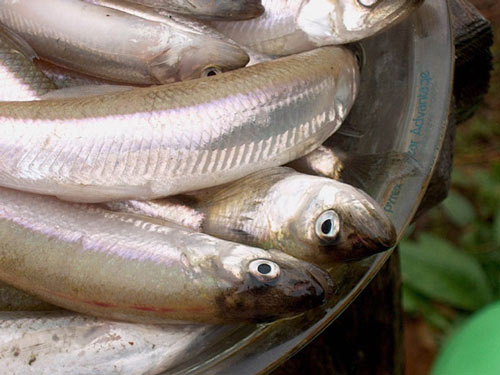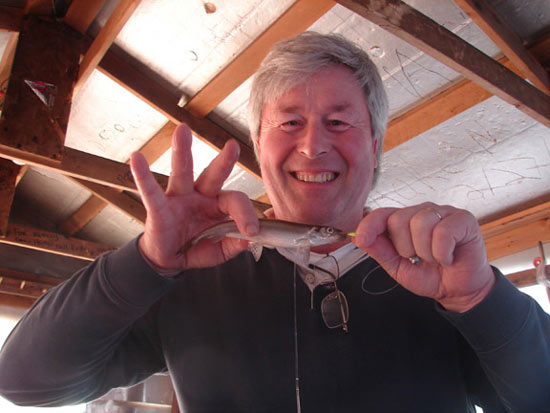Smelt Camp – A Coastal Maine Tradition
by Tom Seymour

If smelt cooperate in a big way, don’t feel bad about taking your catch home. Fortunately for all, Maine still has plenty of smelt. Photo by Tim Seymour
They appear each winter, up and down the coast of Maine. Smelt camps, commercial enterprises, places where winter-weary Mainers go to catch some tasty smelt and share in a communal experience the likes of which exists nowhere else.
Tales of deer camp and trout and salmon camp abound. Books, dedicated to the goings-on in such places line countless shelves in public and private libraries throughout the Pine Tree State. But smelt camp? Other than those living on the coast, or who hail from that region, who has ever heard of a “smelt camp?”
The answer, it turns out, is a growing number of people who love outdoor recreation, enjoy a leisurely ice-fishing trip, one geared toward supplying creature comforts and of course, enjoy catching and eating rainbow smelt, Osmerus mordax. And all of the above come wrapped up in one neat package at any commercially-operated smelt camp.
A smelt camp consists of any number of small shacks, or ice-fishing houses. These often feature benches, pre-cut holes, pre-rigged fishing lines, electric lights and even a small woodstove for heat. Thus, even on those sub-zero nights (which is when most folks go to smelt camp), sports can sit inside a smelt shack in sweaters or even shirtsleeves.
These camps are designed to accommodate various numbers of anglers and the cost of renting one varies according to whether the camp is a 4-person, 6-person, and so on, unit. In most instances, shacks are rented out for the duration of a tide, either incoming or outgoing. This works well, since smelt move in and out of tidal rivers with the tide.
Shack Specifics
Enter a typical smelt shack and the first thing that catches the eye is the pre-cut hole, or holes on either side of the shack. These are rectangular and above each hole, is suspended a long pole. On this pole is a little wooden line holder, filled with monofilament line. Each line has a tiny hook at the end and also, a relatively heavy sinker, or plummet, designed to hold the baited hook steady in even the strongest current.
Often, the pole itself is suspended from the wall or ceiling by some kind of spring or similar device. Shaking this results in the pole bouncing up and down, which in turn moves the bait around and hopefully, attracts passing smelt and stirs them to take the bait.
Bait consists of bloodworms, dug in midwinter from Maine’s mudflats by hardy souls who don’t mind braving ice water and sub-zero windchills. The harvest of marine worms for fish bait is a long-running Maine industry and Maine worms often wind up in the deep south, where people use them when fishing for striped bass. But a good deal of them just stay right here in Maine, at smelt camps on our various tidal rivers.
Smelt don’t bite well on large baits, so bloodworms are cut into small pieces and inserted on the tiny, size 10 hook commonly used at smelt camp. Newcomers to the sport sometimes get an unpleasant surprise when handling marine worms. These harmless-looking creatures are armed with four, retractable fangs and each is loaded with a potent venom. A bloodworm bite rivals and in fact exceeds, the most painful bee sting.
In time, newbies learn that the thin, tapered part of a marine worm is the tail, harmless and easy to deal with, and the larger, thicker end houses these vicious fangs. It takes only one bite to discern this otherwise trifling difference.
If smelt cooperate in a big way, don’t feel bad about taking your catch home. Fortunately for all, Maine still has plenty of smelt. Photo by Tim Seymour
Fishing Tips
To begin fishing, the angler must bait up any number of lines and set them down beneath the ice. It pays to avoid the tendency to set out all lines at once. This usually results in missed bites and lots of stolen bait when a school of smelt passes by. Better to set out three or four lines and to monitor them closely.
A bite doesn’t always come as anything earthshaking. Rather, the line may simply twist one way or the other or perhaps, it will move from center of the ice hole toward the side. Either of these indicates that a smelt has taken the bait. All it needs now is for the angler to quickly pull up the line and with it, hopefully, bright silver, wriggling smelt.
As with any kind of fishing, smelt fishing has its ups and downs, times when fish bite like crazy and times when they seem to have vanished. Either one of these situations can change in the wink of an eye, so diligent line tending becomes necessary for success.
Some people, this writer included, enjoy jigging for smelt with a short, ice-jigging rod. This is easy to do when using only three or four droplines, but gets in the way with more lines. Smelt, despite their 6- to 8-inch size, put up a respectable tussle when taken on a tiny, lightweight jig rod. Small jigs, the kind used for panfish in freshwater lakes and ponds, take smelt. But most everyone uses bait instead. And in this case, marine worms are not the only game in town. Small bits of cooked shrimp and even thin, tiny slices of flesh from a smelt belly, work well for saltwater smelt.
Fishing never comes with any kind of guarantee. But more often than not, people fishing from one of these smelt shacks come home with many meals worth of fresh smelt. In fact, during a good run, one person can land many quarts of these delicious fish. And regarding laws pertaining to smelt fishing with hook and line, Maine Department of Marine Resources (DMR) allows for no bag limit until March 15. Then, the limit is two quarts per person.
Before going on, consider how any saltwater species can be so lightly regulated. This points to the vast size of the resource. Certainly, DMR would not permit a no-bag-limit law if there were the slightest chance of harming the smelt population. It is clear then that the recreational smelt industry has little effect upon smelt numbers. So if smelt cooperate in a big way, don’t feel bad about taking your catch home. Fortunately for all, Maine still has plenty of smelt.
For anyone planning a smelt-fishing trip to any of the various smelt camps, it might pay to go online to the DMR website. Just type in Maine Department of Marine Resources and when the page opens, scroll down for a list of commercially-operated smelt camps. This listing is not all-inclusive, since it only covers Merrymeeting Bay and the lower Kennebec River. But it does provide a start.
To help in planning, the DMR site lists prices for various camps. These are, as mentioned earlier, set according to shack size. Prices for a 2-person camp begin at $14, with an extra $3 for bait, not a bad deal for four hours of comfortable fishing. Prices top at around $25 per 2-person camp and $45 for a 4-person shack. But even that, when divided four ways, seems more than reasonable by anyone’s standards.
While drop-ins are welcome in most camps, it always pays to call ahead to see if any shacks are available when you wish to visit. Also, given the variable nature of ice, especially on tidal water, it makes sense to call, especially early in the season, to make sure that camps are up and running.
Before leaving this interesting topic, remember that anyone may, if they wish, walk out on any frozen river, cut a hole and began fishing. Also, many individuals, especially in Down East parts of Maine, have their own personal shacks that they set out for themselves and friends. So one or two shacks on some sheltered cove do not necessarily indicate a commercial camp.
But for most people, the do-it-yourself route involves lots of muss, fuss and bother. It seems cheaper and definitely easier, to take advantage of the wonderful opportunity offered by any of the various commercial operators.
If you plan on giving this sport a try, there are a few things to include in your gear. First, even though most camps feature a cheery woodstove, stoves run out of wood and temperatures can drop quickly. It’s far easier to take a coat off than to find one to put on when needed. Also, wear heavy, insulated boots. Standing on ice, even in a comfy shack, means cold feet.
Some people like to eviscerate their smelt in the shack before leaving for home. So bring a fillet or other thin-bladed knife, a small cutting board and some plastic bags to hold the cleaned fish. Note that camp operators discourage dropping fish cleanings down ice holes, so save them in a separate bag and take home to dispose of properly. By the way, smelt heads and innards make great compost for any garden.
• A plastic 5-gallon pail works well to hold jigging rod, bait and smelt.
• A small cooler serves to hold beverages, sandwiches and snacks.
• Finally, don’t forget a camera, useful for capturing memories of a special time spent in a special place, a smelt camp on one of Maine’s frozen tidal rivers.

